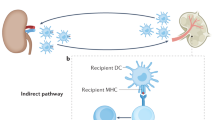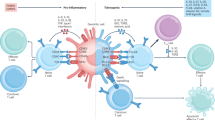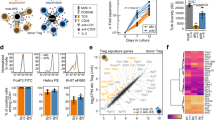Abstract
The diversity of alloreactive T cells in graft rejection and the presence of extensive crossreactivity among alloreactive T cells indicate that the induction of transplantation tolerance may fundamentally alter the size of host T-cell repertoire involved in protective immunity and immune surveillance, especially those that are crossreactive to conventional antigens. We herein highlight the crossreactive nature of alloreactive T cells and the potential risks of altered T-cell repertoire associated with the induction of transplantation tolerance. The possibility that T-cell tolerance to one set of antigens results in their tolerance to other unrelated antigens due to T-cell crossreactivity and/or heterogeneity is defined as ‘cross-immune tolerance’. The definition and significance of this concept were discussed in details.
This is a preview of subscription content, access via your institution
Access options
Subscribe to this journal
Receive 12 digital issues and online access to articles
$119.00 per year
only $9.92 per issue
Buy this article
- Purchase on Springer Link
- Instant access to full article PDF
Prices may be subject to local taxes which are calculated during checkout



Similar content being viewed by others
References
Ashwell JD, Chen C, Schwartz RH . High frequency and nonrandom distribution of alloreactivity in T cell clones selected for recognition of foreign antigen in association with self class II molecules. J Immunol 1986; 136: 389–395.
Suchin EJ, Langmuir PB, Palmer E, Sayegh MH, Wells AD, Turka LA . Quantifying the frequency of alloreactive T cells in vivo: new answers to an old question. J Immunol 2001; 166: 973–981.
Adams AB, Williams MA, Jones TR, Shirasugi N, Durham MM, Kaech SM, et al. Heterologous immunity provides a potent barrier to transplantation tolerance. J Clin Invest 2003; 111: 1887–1895.
Finberg R, Burakoff SJ, Cantor H, Benacerraf B . Biological significance of alloreactivity: T cells stimulated by Sendai virus-coated syngeneic cells specifically lyse allogeneic target cells. Proc Natl Acad Sci USA 1978; 75: 5145–5149.
Pantenburg B, Heinzel F, Das L, Heeger PS, Valujskikh A . T cells primed by Leishmania major infection cross-react with alloantigens and alter the course of allograft rejection. J Immunol 2002; 169: 3686–3693.
Taylor DK, Neujahr D, Turka LA . Heterologous immunity and homeostatic proliferation as barriers to tolerance. Curr Opin Immunol 2004; 16: 558–564.
Brehm MA, Pinto AK, Daniels KA, Schneck JP, Welsh RM, Selin LK . T cell immunodominance and maintenance of memory regulated by unexpectedly cross-reactive pathogens. Nat Immunol 2002; 3: 627–634.
Mason D . A very high level of crossreactivity is an essential feature of the T-cell receptor. Immunol Today 1998; 19: 395–404.
Adams AB, Pearson TC, Larsen CP . Heterologous immunity: an overlooked barrier to tolerance. Immunol Rev 2003; 196: 147–160.
Sachs DH . Tolerance: of mice and men. J Clin Invest 2003; 111: 1819–1821.
Zhao Y, Li XC . Transplant tolerance: is it really free of concerns? Trends Immunol 2007; 28: 376–377.
Markovic-Plese S, Hemmer B, Zhao Y, Simon R, Pinilla C, Martin R . High level of cross-reactivity in influenza virus hemagglutinin-specific CD4+ T-cell response: implications for the initiation of autoimmune response in multiple sclerosis. J Neuroimmunol 2005; 169: 31–38.
Hausmann S, Martin M, Gauthier L, Wucherpfennig KW . Structural features of autoreactive TCR that determine the degree of degeneracy in peptide recognition. J Immunol 1999; 162: 338–344.
Zhao Y, Gran B, Pinilla C, Markovic-Plese S, Hemmer B, Tzou A, et al. Combinatorial peptide libraries and biometric score matrices permit the quantitative analysis of specific and degenerate interactions between clonotypic TCR and MHC peptide ligands. J Immunol 2001; 167: 2130–2141.
Bhardwaj V, Kumar V, Geysen HM, Sercarz EE . Degenerate recognition of a dissimilar antigenic peptide by myelin basic protein-reactive T cells. Implications for thymic education and autoimmunity. J Immunol 1993; 151: 5000–5010.
Oldstone MB, Nerenberg M, Southern P, Price J, Lewicki H . Virus infection triggers insulin-dependent diabetes mellitus in a transgenic model: role of anti-self (virus) immune response. Cell 1991; 65: 319–331.
Casrouge A, Beaudoing E, Dalle S, Pannetier C, Kanellopoulos J, Kourilsky P . Size estimate of the alpha beta TCR repertoire of naive mouse splenocytes. J Immunol 2000; 164: 5782–5787.
Wagner UG, Koetz K, Weyand CM, Goronzy JJ . Perturbation of the T cell repertoire in rheumatoid arthritis. Proc Natl Acad Sci USA 1998; 95: 14447–14452.
Arstila TP, Casrouge A, Baron V, Even J, Kanellopoulos J, Kourilsky P . A direct estimate of the human alphabeta T cell receptor diversity. Science 1999; 286: 958–961.
Nikolich-Zugich J, Slifka MK, Messaoudi I . The many important facets of T-cell repertoire diversity. Nat Rev Immunol 2004; 4: 123–132.
Reiser JB, Darnault C, Gregoire C, Mosser T, Mazza G, Kearney A, et al. CDR3 loop flexibility contributes to the degeneracy of TCR recognition. Nat Immunol 2003; 4: 241–247.
Goldrath AW, Bevan MJ . Selecting and maintaining a diverse T-cell repertoire. Nature 1999; 402: 255–262.
Kersh GJ, Allen PM . Essential flexibility in the T-cell recognition of antigen. Nature 1996; 380: 495–498.
Reay PA, Kantor RM, Davis MM . Use of global amino acid replacements to define the requirements for MHC binding and T cell recognition of moth cytochrome c (93–103). J Immunol 1994; 152: 3946–3957.
Gautam AM, Lock CB, Smilek DE, Pearson CI, Steinman L, McDevitt HO . Minimum structural requirements for peptide presentation by major histocompatibility complex class II molecules: implications in induction of autoimmunity. Proc Natl Acad Sci USA 1994; 91: 767–771.
Lang HL, Jacobsen H, Ikemizu S, Andersson C, Harlos K, Madsen L, et al. A functional and structural basis for TCR cross-reactivity in multiple sclerosis. Nat Immunol 2002; 3: 940–943.
Ignatowicz L, Kappler J, Marrack P . The repertoire of T cells shaped by a single MHC/peptide ligand. Cell 1996; 84: 521–529.
Ignatowicz L, Rees W, Pacholczyk R, Ignatowicz H, Kushnir E, Kappler J, et al. T cells can be activated by peptides that are unrelated in sequence to their selecting peptide. Immunity 1997; 7: 179–186.
Wucherpfennig KW . T cell receptor crossreactivity as a general property of T cell recognition. Mol Immunol 2004; 40: 1009–1017.
Cohn M . Degeneracy, mimicry and crossreactivity in immune recognition. Mol Immunol 2005; 42: 651–655.
Page KR, Scott AL, Manabe YC . The expanding realm of heterologous immunity: friend or foe? Cell Microbiol 2006; 8: 185–196.
Fujinami RS, Oldstone MB . Molecular mimicry as a mechanism for virus-induced autoimmunity. Immunol Res 1989; 8: 3–15.
Vanderlugt CL, Miller SD . Epitope spreading in immune-mediated diseases: implications for immunotherapy. Nat Rev Immunol 2002; 2: 85–95.
Warnock MG, Goodacre JA . Cryptic T-cell epitopes and their role in the pathogenesis of autoimmune diseases. Br J Rheumatol 1997; 36: 1144–1150.
Mongkolsapaya J, Dejnirattisai W, Xu XN, Vasanawathana S, Tangthawornchaikul N, Chairunsri A, et al. Original antigenic sin and apoptosis in the pathogenesis of dengue hemorrhagic fever. Nat Med 2003; 9: 921–927.
Daniel C, Horvath S, Allen PM . A basis for alloreactivity: MHC helical residues broaden peptide recognition by the TCR. Immunity 1998; 8: 543–552.
Blattman JN, Antia R, Sourdive DJ, Wang X, Kaech SM, Murali-Krishna K, et al. Estimating the precursor frequency of naive antigen-specific CD8 T cells. J Exp Med 2002; 195: 657–664.
Hornick PI, Brookes PA, Mason PD, Taylor KM, Yacoub MH, Rose ML, et al. Optimizing a limiting dilution culture system for quantifying the frequency of interleukin-2-producing alloreactive T helper lymphocytes. Transplantation 1997; 64: 472–479.
Welsh RM, Markees TG, Woda BA, Daniels KA, Brehm MA, Mordes JP, et al. Virus-induced abrogation of transplantation tolerance induced by donor-specific transfusion and anti-CD154 antibody. J Virol 2000; 74: 2210–2218.
Williams MA, Onami TM, Adams AB, Durham MM, Pearson TC, Ahmed R, et al. Cutting edge: persistent viral infection prevents tolerance induction and escapes immune control following CD28/CD40 blockade-based regimen. J Immunol 2002; 169: 5387–5391.
Burrows SR, Silins SL, Khanna R, Burrows JM, Rischmueller M, McCluskey J, et al. Cross-reactive memory T cells for Epstein–Barr virus augment the alloresponse to common human leukocyte antigens: degenerate recognition of major histocompatibility complex-bound peptide by T cells and its role in alloreactivity. Eur J Immunol 1997; 27: 1726–1736.
Burrows SR, Khanna R, Burrows JM, Moss DJ . An alloresponse in humans is dominated by cytotoxic T lymphocytes (CTL) cross-reactive with a single Epstein–Barr virus CTL epitope: implications for graft-versus-host disease. J Exp Med 1994; 179: 1155–1161.
Yang H, Welsh RM . Induction of alloreactive cytotoxic T cells by acute virus infection of mice. J Immunol 1986; 136: 1186–1193.
Carlquist JF, Shelby J, Shao YL, Greenwood JH, Hammond ME, Anderson JL . Accelerated rejection of murine cardiac allografts by murine cytomegalovirus-infected recipients. Lack of haplotype specificity. J Clin Invest 1993; 91: 2602–2608.
Landais E, Morice A, Long HM, Haigh TA, Charreau B, Bonneville M, et al. EBV-specific CD4+ T cell clones exhibit vigorous allogeneic responses. J Immunol 2006; 177: 1427–1433.
Williams MA, Tan JT, Adams AB, Durham MM, Shirasugi N, Whitmire JK, et al. Characterization of virus-mediated inhibition of mixed chimerism and allospecific tolerance. J Immunol 2001; 167: 4987–4995.
Vu MD, Clarkson MR, Yagita H, Turka LA, Sayegh MH, Li XC . Critical, but conditional, role of OX40 in memory T cell-mediated rejection. J Immunol 2006; 176: 1394–1401.
Heeger PS, Greenspan NS, Kuhlenschmidt S, Dejelo C, Hricik DE, Schulak JA, et al. Pretransplant frequency of donor-specific, IFN-gamma-producing lymphocytes is a manifestation of immunologic memory and correlates with the risk of posttransplant rejection episodes. J Immunol 1999; 163: 2267–2275.
Neujahr DC, Chen C, Huang X, Markmann JF, Cobbold S, Waldmann H, et al. Accelerated memory cell homeostasis during T cell depletion and approaches to overcome it. J Immunol 2006; 176: 4632–4639.
Zhao Y, Sykes M . Resistance to monoclonal antibody-induced CD8+ T-cell depletion in thymectomized MHC class II-deficient mice. Transplantation 1997; 64: 489–494.
Kean LS, Gangappa S, Pearson TC, Larsen CP . Transplant tolerance in non-human primates: progress, current challenges and unmet needs. Am J Transplant 2006; 6: 884–893.
Sykes M . Mixed chimerism and transplant tolerance. Immunity 2001; 14: 417–424.
Wood KJ, Sakaguchi S . Regulatory T cells in transplantation tolerance. Nat Rev Immunol 2003; 3: 199–210.
Blankenstein T, Schuler T . Cross-priming versus cross-tolerance: are two signals enough? Trends Immunol 2002; 23: 171–173.
Heath WR, Kurts C, Miller JF, Carbone FR . Cross-tolerance: a pathway for inducing tolerance to peripheral tissue antigens. J Exp Med 1998; 187: 1549–1553.
Waldmann H, Adams E, Fairchild P, Cobbold S . Infectious tolerance and the long-term acceptance of transplanted tissue. Immunol Rev 2006; 212: 301–313.
Sakaguchi S, Sakaguchi N, Shimizu J, Yamazaki S, Sakihama T, Itoh M, et al. Immunologic tolerance maintained by CD25+ CD4+ regulatory T cells: their common role in controlling autoimmunity, tumor immunity, and transplantation tolerance. Immunol Rev 2001; 182: 18–32.
Karim M, Feng G, Wood KJ, Bushell AR . CD25+CD4+ regulatory T cells generated by exposure to a model protein antigen prevent allograft rejection: antigen-specific reactivation in vivo is critical for bystander regulation. Blood 2005; 105: 4871–4877.
Ballet C, Roussey-Kesler G, Aubin JT, Brouard S, Giral M, Miqueu P, et al. Humoral and cellular responses to influenza vaccination in human recipients naturally tolerant to a kidney allograft. Am J Transplant 2006; 6: 2796–2801.
Acknowledgements
This work was supported by grants from the key grant of the National Natural Science Foundation (no. 30630060, Y Zhao), the Knowledge Innovation Program of Chinese Academy of Sciences (no. KSCX2-SW-333, Y Zhao) and the National Natural Science Foundation for Distinguished Young Scholars (no. C03020504, Y Zhao).
Author information
Authors and Affiliations
Corresponding authors
Rights and permissions
About this article
Cite this article
Zhao, Y., Li, X. Cross-immune tolerance: conception and its potential significance on transplantation tolerance. Cell Mol Immunol 7, 20–25 (2010). https://doi.org/10.1038/cmi.2009.101
Received:
Accepted:
Published:
Issue Date:
DOI: https://doi.org/10.1038/cmi.2009.101



